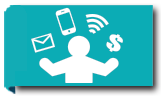
Q2 Technology Applications & Tools for Note Taking
This page provides some tips and tools to address your Myers-Briggs learning styles...
-
Note taking: Introvert & Sensing,
-
Organizers: Introvert, Perceiving & Sensing.
Note-Taking
Note-taking is essential, whether listening to a lecture in your classroom, watching an instructional video, or attending a class virtually online. Taking notes can help you remember and also focus on the information. You can take notes by handwriting them with paper and pencil/pen or typing or entering them into a document using a digital device (computer or mobile device).
Advantages of using a computing device include:
- easily editing them
- accessing them from any other digital device
- sharing them with others.
Some digital features that help make note-taking effective
- highlighting or bolding important points
- being able to retrieve and organize them
- adding links to media such as videos, images, and special resources online
Research shows that note-taking in any form stimulates your brain and helps the information go from short-term to longer-term memory.
Below are some of the popular and user-friendly apps:
Google Keep & Microsoft OneNote Options
Google Keep: Android, iOS, and Google Keep look like a basic sticky note-taking app, but there's a “Copy to Google Doc” feature, which turns any note into an editable Google Doc where you can add images, comments, and links to files. Google Keep's most helpful feature is audio transcription. When you record your thoughts with Keep’s audio recorder in its mobile apps, Google transcribes the text and records the audio. | Use these step-by-step Google Keep instructions for downloading and using Keep to take notes. This How to Use Google Keep Tutorial YouTube Video has step-by-step instructions. |
| Microsoft OneNote: is part of the Microsoft Office Suite and is designed around notebooks and note sections. It feels just like a paper note, as you can begin keyboarding anywhere on the note. You can add images, file attachments, notes, highlighting, audio, and sketches. | This video, Microsoft OneNote for Windows 10 Tutorial YouTube, for 2022, will assist you in learning all the ins and outs of OneNote. If you have an older version, check YouTube for tutorials. |
| Apple Notes: It is free with macOS/iOS devices, and it lets you type or take notes by hand. Capture quick thoughts and save more extended notes filled with checklists, images, web links, scanned documents, handwritten notes, or sketches. The drawing features are solid, making adding sketches and illustrations to your notes easy. When using iCloud, it's easy to keep all your devices in sync, so you’ll always have your notes. | This video, Why Apple Notes may be the Best Note-Taking App YouTube (16:46 mins), compares the features of Google Keep, Microsoft Onenote, and Apple Notes. |
Microsoft OneNote video
Direct link (4:30 min)
Top Tips for Note-taking
Consider your Personality Learning Style. Some of the tools suggested may not be your best way of learning, organizing, and remembering important ideas.
It should be a helpful tool and not a distraction or be cumbersome. If you find yourself getting distracted, switch the type of note-taking you are using to a different kind. Remember, these note-taking tools are only as good as what you do with them after you have taken them.
Reviewing notes tips:
- Within the first 24 hours
- A small portion of them every day
- Have your notes with you as you do other readings or research
| Consider using an organizer such as Cornell Notes. | Divide your paper into three sections: notes, cues, and summary. Refer to this Cornell Note Taking Method YouTube (2:31 mins) video. |
| Mind maps are a great way of taking notes for specific subjects. | Use the mind map to get a handle on how certain topics relate or to go in-depth with one particular idea. Mind Maps YouTube (2 mins) video. |
| Flow notes | Jot down topics, draw arrows, and make little doodles, diagrams, and graphs. Video tutorial (2:16) |
| Take notes on Slides (using Google Slides, PowerPoint slides) | Download presentations by your teacher. You can then add notes, edit them, highlight important points, and/or print them out. |
| Bullet Journaling | Use a blank piece of paper and jot down your notes, draw images, and use arrows to connect ideas. |
Credits: How to Take Better Notes
GRAPHIC Organizers
Students with good organization skills can create and maintain ways to keep track of information or materials. A graphic organizer is an aid to move ideas and information from short-term memory into long-term memory. A graphic organizer is:
- A visual or graphic display organizes ideas and demonstrates relationships between different information and concepts.
- Sometimes referred to as knowledge maps, concept maps, story maps, cognitive organizers, advanced organizers, or concept diagrams.
See some examples of: "15 Graphic Organizers and How They Help Visualize Ideas"
Some digital graphic organizer tool suggestions:
- Google Slides or Microsoft PowerPoint
- Canva
- You may have other digital tools that your teacher suggests or already know about.
Graphic Organizer Options
You can watch a Mind Map Tutorial with Google Slideshow YouTube (4:32) and/or make a copy of this Google Slideshow Brainstorm Document;
| Visual Learning Resources | Refer to 2.Q1 Visual Learning-Fire Rescue |
| Canva offers free online graphic organizer templates for students. You must have an email, Google, or Facebook account to create an account. | Canva Free Templates for Students. Canva Design Graphic Organizer Activities YouTube (2:44mins) |
| For Google Slides. | You can watch the Mind Map Tutorial with Google Slideshow YouTube (4:32) or make a copy of this Google Slideshow Brainstorm Document. |
Websites
Websites
- 15 Graphic Organizers and How They Help Visualize Ideas
- Canva
- Canva Free Templates for Students
- Google Keep Instructions
Videos from Outside Sources
- Bubbl Cool Tools Presentation YouTube (4:48)
- Canva Design Graphic Organizer Activities YouTube (2:44 mins)
- Cornell Note Taking Method YouTube (2:31 mins)
- Flow Note-Taking Method YouTube (2:16 mins.)
- How to use Google Keep Tutorial YouTube (15:51 mins)
- Microsoft OneNote for Windows 10 Tutorial YouTube (23:36 mins)
- Mind Maps YouTube (2 mins)
- Using OneNote/Basics for Students (4:31 mins)
- Why Apple Notes May be the Best Note-Taking App YouTube (16:46 mins)
21t4s Websites


